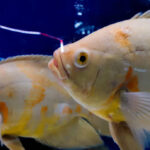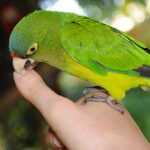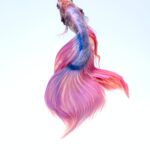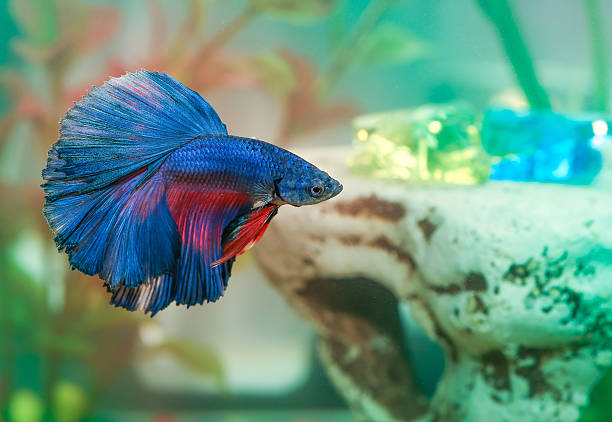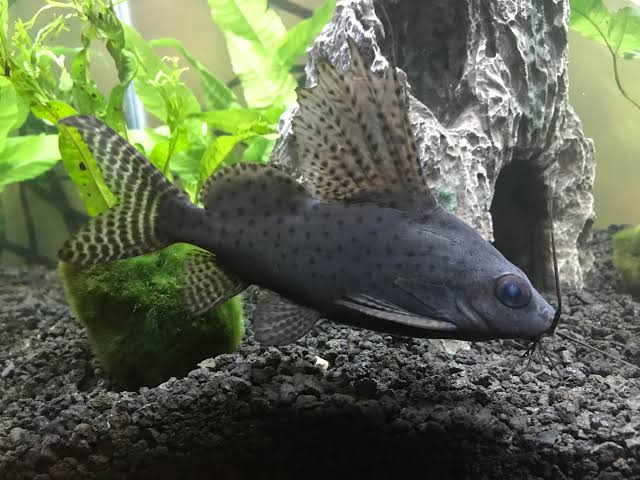The male Betta’s tail is elongated, which makes it stand out from other aquarium fish. The female Betta is pretty but duller and has fewer fins or tails. What’s up with the male betta fin and tail variations?
LONG-TAIL BETTAS ARE DISTINCT FROM SHORT TAILS
Bettas have several individual fins as well as a pair around their body. These fins are used to help them swim and move in three-dimensional space underwater.
Some bettas have been bred to have longer fins, wider fins, or fins with a special shape.
- The most common feature of rare bettas is their tail or caudal finne.
- The lower or anal fin of the fish is another.
- Some varieties can also have elaborate or elongated pectoral fins, ventral or dorsal.
Why don’t wild bettas have these traits?
Elongated fins and tails can make it difficult to swim through vegetation. In the wild, even the most beautiful and graceful betta fish will be severely disadvantaged.
List of Betta Varieties:
I’ve tried to compile the most current list of bettas. In some cases, different varieties are known by different names around the world. I will use the most popular name.
My descriptions of these types are not meant to represent the standards of a show. This article is meant to provide someone who has never kept fancy bettas with a good idea of all the fascinating varieties they can consider for their aquarium.
Betta fish colors:
Bettas are available in a wide range of colors, from the brightest reds to the deepest blacks and the purest whites.
Many bettas aren’t just one color. They have multiple distinct pigmentation patterns. In the Patterns section, I discuss some of these examples.
Some color variations can have a two-tone appearance. The body and fins may be of different shades or colors, like the chocolate betta.
This is the most comprehensive list I could find of betta color varieties, with facts and information on each variety.
ALBINO:
An albino betta completely lacks pigmentation. The person with albinism should have pink or red eyes and off-white scales. The muscles and organs of the fish can be seen through their scales.
Albino animals in the wild are at a disadvantage because the ultraviolet light of the sun can cause a lot of damage. This often results in cancer and blindness. Other mutations and health issues are also common.
Albino Bettas are extremely rare, and it’s even questionable whether they exist. The majority of reports probably refer to clear/cellophane or white varieties. These are extremely difficult to breed, and their survival rate is low.
CLEAR / CELLOPHANE:
Transparent or cellophane Betta also has white to translucent scales. Sometimes, the pink color of their internal organs and muscles can be seen through their scaling. Fins can be transparent or opaque. His eyes should be black.
The chromatophores of clear or cellophane Bettas are one of three different pigments. This trait does not show, and the fish looks almost colorless.
WHITE:
The fins of some white bettas can be duller than others. White bettas should not have a pinkish body, unlike cellophane types.
It may not seem impressive, but you will be amazed at the amount of detail in the fins and body of a betta that is pure white.
BLACK:
Black bettas come in a variety of colors and have subtle differences.
- Black Melano Bettas are the purest and darkest black. The opposite of people with albinism, they have an excess of melanin pigments. This type is usually sterile, and it can cause health problems.
- Black Lace Bettas are dark in color, but they’re not as vibrant as melanoma bettas. They are often completely or partially colored in cellophane. They are typically fertile.
- Black Orchid Bettas have bicolor crown tails with a dark, iridescent body. Some may interbreed marble-patterned Bettas to give them a metallic, red, or orange hue along their fins or on their body. Black Devil and Black Ice are hybrids of black orchids.
- The black copper betta is a hybrid of a female copper betta and a fertile black melano. The offspring are a mix of metallic and deep black scales.
BLUE:
Blue is not an uncommon color in nature. However, bettas are the exception.
It’s funny to note that the blue color is not due to pigments but rather the scales and pigment cells, as well as how the light reflects. Bettas are a vibrant shade of blue that is not usually seen in fish.
Blue Bettas are most commonly seen in the following colors:
- Steel blue Bettas are grayish-blue colored.
- Royal blue Bettas have dark blue fins and a body with a deep blue color.
- Turquoise bettas with vibrant, rich color and a hint of green
COPPER:
A copper betta looks brown or tan in low light. Once you turn the light on, the brilliant radiance will be visible. These fish have metallic fins and scales that are highly reflective.
CHOCOLATE:
The body of a chocolate betta is brown or tan, with orange or yellow fins or tail. These are typically bicolor bettas.
Green:
Green Bettas usually appear solid green, but tilting the light in the right direction will reveal the true color. The fins and bodies of betta fish can look black, blue, turquoise, or even black, depending on the angle. Most green bettas have a metallic overlay that covers their color.
Mustard Gas:
The mustard gas betta is a very common fish. It has a body of blue or green that gradually fades to orange or yellowish fins. Their fins can also have a blackish tint. The bodies are brown, but they lack the chocolate coloration of the chocolate betta.
PIE:
The pastel betta has a pale, pastel fin and body color with an off-white wash over the primary color. This gives it a paler look.
ORANGE:
They are rare and usually bright orange. These bettas are less common than blue or red bettas but more common than purple or green bettas.
- Orange Dalmatian Bettas have a pale, orange-colored body with bright orange spots that are almost red along their fins.
PURPLE:
Purple bettas can be very rare. If you find one, you’ll have to pay a lot of money for it. Purple bettas that are true to color are rare.
Many fish are violet, but the color fades to red, blue, or lavender. The violet and pale lavender bettas may be more common, but they are still rare.
NET:
Red is one of the most popular betta colors. Red highlights are found in many bicolor patterns and other bettas.
YELLOW:
The body shape and fins of a yellow betta should be a brightly colored lemon. Yellow bettas can be difficult to breed and are not common.
PATTERNS and DESIGNS TO SCALE
Bettas are available in a wide variety of patterns. They range from goldfish that look like solids to ones that have been dressed up for a party.
Some fish have an overlying metallic wash, which gives them a shiny look. Some fish have metallic-colored scales and fins.
The most common patterns and designs of scales are:
SOLID:
Solid color bettas are only one color. The color of the fins may be more intense or darker than the body because the pigments are closer to the muscles.
The solid Betta is a beautiful fish that makes a great choice for breeding.
BI-COLOR:
Some people refer to any fish that has two colors as a bicolor>>.
This is a common pattern in bettas.
BUTTERFLY:
The butterfly betta has a solid-colored body and cellophane-shaded fins. The line between color and cellophane is very sharp in higher-quality specimens. The specimens can have two or three colors, and between half and one-third of the body will show each color.
This variety is not desirable in the betta show industry, even though it can be bred to have a variegated trait.
CAMBODIAN:
The Cambodian-style betta is a classic bi-color fish with a pale pink or white body and red fins. This type was once quite common but is now much more difficult to find.
DRAGON SCALE:
This trait was deliberately incorporated into the Betta magnificent line of wild Bettas. Dragon scale bettas are thicker, and you can clearly see each scale. The fish look like they are covered in jewels. It is similar to scale mail armor.
The dragon scale can be combined with other pigment patterns or solid colors. A dragon-scale betta can look spectacular, depending on the combination!
MARBLE:
The marble betta is unique and has a frustrating quality. The marble feature doesn’t appear instantly. Randomly, it activates during the lifespan of the fish. It darkens the primary color of the fish and causes pale spots to appear on its body and fins.
The fish will start with a certain color pattern or color and then suddenly change. This can be a dramatic change. When bred together with other traits, like the butterfly betta, this trait can be undesirable.
- Marbles and betta fish with koi patterns are closely related. This trait is more common in plakat-type Bettas. Koi bettas have been bred in order to look like the koi that are often found in Japanese ponds.
MASK:
Mask bettas have a head the same color as their body. The majority of bettas have different colors on their heads unless they were bred to have the mask gene.
- Half-mask bettas are characterized by having half of the heads in the same color as their bodies and the other half in a different color.
WINE:
The grizzle beta has a split of 50-50 between lighter and darker colors. The grizzle Betta is a variety that has alternating lighter and darker colors.
MULTICOLOR / TRICOLOR:
Tricolor Bettas are characterized by an uneven mixture of colors on their fins and body. Multicolored Bettas are a mixture of at least three colors and may have more. The color mix is usually random and unpredictable.
PIEBALD:
Piebald Bettas has a lighter body and a face that is white or flesh-colored. The albinism trait is not present in these fish, unlike other animals with pitted coloring.
Types of Betta Fins and Tails
After I’ve shared all I know about the colors and patterns of betta fish, let’s talk about their fins. The sleek tails of these fish are one of their most attractive features.
We can talk about the fins of bettas in terms of their configuration:
VEIL TAIL:
Veil Tail, or VT, is the most popular type of Betta.
The VT betta is characterized by a long tail, which droops when it swims. It looks like a large sail dragging through the ocean. They are healthy and beautiful fish, but they can bite their fins if stressed.
COMB:
The comb tail is a newer variation, also known as half-sun Betta. The comb tail does not have a web in its tail that extends from one ray into the next. Instead, it has a space between each ray. The tail will appear to have a large number of teeth.
The cola is usually healthy and fertile, but it can suffer from a lack of support. Some combtails have droopy, ugly tails. It is not a problem for the fish, but it can make it look sad.
CROWNTAIL:
Crowntail Betta is another combtail-related variety. The web of these fish does not reach the fin rays. Instead of looking like the comb it is, its tail appears pointed or upside-down.
Crown tails are also prone to kinking their tails. Even females with shorter tails can be affected by this. Crowtails, on the other hand, are generally healthy and fertile. The webbing on their fins is also reduced, so they don’t pinch themselves as much.
DELTA:
The delta betta has a unique variety. Their tails, when fully extended, form an angle less than 180° from the base to the edge. The Greek letter Delta is used to name them because of their triangular tails with straight edges.
They come in many colors and patterns. Deltas are beautiful fish. It’s hard to tell the difference between them and crescent bettas. The super Delta and Delta are both generally healthy and not more susceptible to fin rot.
- The Super Delta has a similar shape, but the tails are wider. They extend nearly 180 degrees.
DOUBLE TAIL:
The twin-tail is also known as the twin-tailed Betta. It has large and wide anal, caudal and dorsal fins. The tail fin looks like two tails.
They are very unusual and conspicuous fish. These fish are accessible in a large range of colors and patterns.
These fish are in poor health because of the double tails. The fish are often prone to fin diseases and swim bladder issues. These bettas are beautiful but don’t live as long as other betta varieties.
Half MOON:
As I said earlier, the half-moon Betta looks nearly identical to that of the Delta variety. The tail of a true crescent is 180 degrees long and can come in any color combination. When viewed sideways, his tail has a D-shape.
The majority of the time, they are considered to be a longfin variety.
The half-moon Betta is the second most popular after the VT variety. Many of these varieties are available in pet shops and aquarium stores. These bettas are susceptible to the typical betta issues but are considered healthy to own.
- Over Half Moon is the variety of Betta, where the tail extends beyond the 180-degree mark.
RETAIL:
The rosetail is a betta with one of the largest and widest tails. The dorsal, anal, and tail fins of these bettas are the most detailed and longest in the entire betta family.
Its fins look like a flower’s petal when it starts to wilt.
This variety tends to have health issues. These fish can bite their tails, and the fins are susceptible to disease. They can get tumors or have problems with their swimming bladders because they’ve been heavily bred for these fins.
POSTER:
Plakat is a more recent variety of Betta, which has become popular in Thailand and elsewhere in Asia. These fish were bred using the Thai Siamese Fighting fish line and crossed with wild Betta splendens.
The tails of many planets are similar to those seen on long-finned bettas. The tail of the plakat is shorter, and more like the wild type than the fancier bettas.
Beginner betta keepers often mistake male plants for long-finned bettas. The plakat is a hybrid species that has been selectively selected. They have a very different behavior profile from the other bettas in this list.
Plakats can be aggressive and cannot usually be kept with other species of fish. Many will only eat fresh food and do not like commercial diets. They are healthy and don’t have fin problems as do long-finned varieties.
PEN:
The feathertail is similar to the rosetail in that it has fins with long, wide waves. Their fins and tail are not crescent-shaped but have triangles on the edge, giving them a feathery>> look. These are less common than the retail, and they come in different colors and patterns.
As with retail, feathertails are prone to health issues. They bite their tails a lot and have swim bladder issues.
ROUND TAIL:
The round-tail Betta is popular in pet shops and similar to the Delta and Crescent. The tails of round-tail betta fish are not straight like those of the Delta but have a rounded shape.
The fish are healthy, but they are susceptible to the typical betta problems and diseases.
















